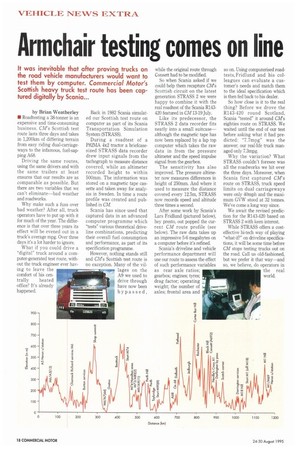Armchair testing comes on line
Page 20

If you've noticed an error in this article please click here to report it so we can fix it.
It was inevitable that after proving trucks on the road vehicle manufacturers would want to test them by computer. Commercial Motor's Scottish heavy truck test route has been captured digitally by Scania...
by Brian Weatherley • Roadtesting a 38-tonner is an expensive and time-consuming business. CM's Scottish test route lasts three days and takes in 1,200km of differing terrain from easy riding dual-carriageways to the infamous, fuel-sapping A68.
Driving the same routes, using the same drivers and with the same trailers at least ensures that our results are as comparable as possible. But there are two variables that we can't eliminate—bad weather and roadworks.
Why make such a fuss over bad weather? After all, truck operators have to put up with it for much of the year. The difference is that over three years its effect will be evened out in a truck's average mpg. Over three days it's a lot harder to ignore.
What if you could drive a "digital" truck around a computer-generated test route, without the truck engineer ever having to leave the comfort of his cen trally heated office? It's already happened. Back in 1982 Scania simulated our Scottish test route on computer as part of its Scania Transportation Simulation System (STRASS).
During a roadtest of a P82M.A 4x2 tractor a briefcasesized STRASS data recorder drew input signals from the tachograph to measure distance covered, while an altimeter recorded height to within 500mm. The information was stored on a magnetic tape cassette and taken away for analysis in Sweden. In time a route profile was created and published in CM Scania has since used that captured data in an advanced computer programme which "tests" various theoretical driveline combinations, predicting their overall fuel consumption and performance, as part of its specification programme.
However, nothing stands still and CM's Scottish test route is no exception. Many of the villages on the A9 we used to drive through have now been bypassed, while the original route through Consett had to be modified.
So when Scania asked if we could help them recapture CMs Scottish circuit on the latest generation STRASS 2 we were happy to combine it with the real roadtest of the Scania R143420 featured in CM13-19 July.
Like its predecessor, the STRASS 2 data recorder fits neatly into a small suitcase— although the magnetic tape has now been replaced by a lap top computer which takes the raw data in from the pressure altimeter and the speed impulse signal from the gearbox.
The sensitivity has also improved. The pressure altimeter now measures differences in height of 250mm. And where it used to measure the distance covered every 12.5m, STRASS now records speed and altitude three times a second.
After some work by Scania's Lars Fridlund (pictured below), hey presto, out popped the current CM route profile (see below). The raw data takes up an impressive 5-6 megabytes on a computer before it's refined.
Scania's driveline and vehicle performance department will use our route to assess the effect of such performance variables as rear axle ratios; gearbox; engines; tyres; drag factor; operating weight; the number of axles; frontal area and so on. Using computerised roadtests, Fridlund and his colleagues can evaluate a customer's needs and match them to the ideal specification which is then fed back to his dealer.
So how close is it to the real thing? Before we drove the R143-420 round Scotland, Scania "tested" it around CM's eighties route on STRASS. We waited until the end of our test before asking what it had predicted: "7.7mpg" was the answer; our real-life truck managed only 7.3mpg.
Why the variation? What STRASS couldn't foresee was all the roadworks we hit over the three days. Moreover, when Scania first captured CM's route on STRASS, truck speed limits on dual carriageways were only 40mph and the maximum GVW stood at 32 tonnes. We've come a long way since.
We await the revised prediction for the R143-420 based on STRASS 2 with keen interest.
While STRASS offers a costeffective hi-tech way of playing "what-if?" on driveline specifications, it will be some time before CM stops testing trucks out on the road. Call us old-fashioned, but we prefer it that way—and so, we believe, do operators in the real world.




























































































































